Projection of National Carbon Footprint in Japan with Integration of LCA and IAMs
Abstract
:1. Introduction
2. Materials and Methods
2.1. Asia-Pacific Integrated Model (AIM)
2.2. Inventory Database Based on Input–Output Analysis
2.2.1. Matrix of Direct Input Coefficients
2.2.2. Direct GHG Emissions
2.2.3. Calculation of Environmental Intensity
2.2.4. Calculation of CFP
2.2.5. Carbon Productivity
3. Results
3.1. Carbon Footprint Projections
3.2. Carbon Productivity
4. Discussion
4.1. Comparison with Previous Studies
4.2. Limitations
5. Conclusions
Author Contributions
Funding
Conflicts of Interest
Appendix A
| Model Name | Institution | Area, Output | Application |
|---|---|---|---|
| Asia-Pacific Integrated Model (AIM) | National Institute for Environmental Science (NIES), Japan | Asia-Pacific, national economic level, GHG emissions | Akimoto et al. (2015) [14] |
| Dynamic Integrated model of Climate and Economy (DICE) | Yale University, USA | Global, industrial and land use CO2, anthropogenic emissions | Su et al. (2017) [28] |
| Global Charge Assessment Model (GCAM) | Joint Global Change Research Institute, USA | 32 geopolitical regions, global primary energy, price of CO2 per ton | Thomson et al. (2011) [29] |
| Integrated Model to Assess the Global Environment (IMAGE) | PBL Netherlands Environmental Assessment Agency, Netherlands | Global and national economic levels, CO2 equivalent, land use | Strengers et al. (2008) [30] |
| Model for Energy Supply Strategy Alternatives and Their General Environmental Impact (MESSAGE) | International Institute for Applied Systems Analysis, Austria | Global and national economic levels, global CO2 emissions, land-use and land-cover change | Keywan et al. (2011) [31] |
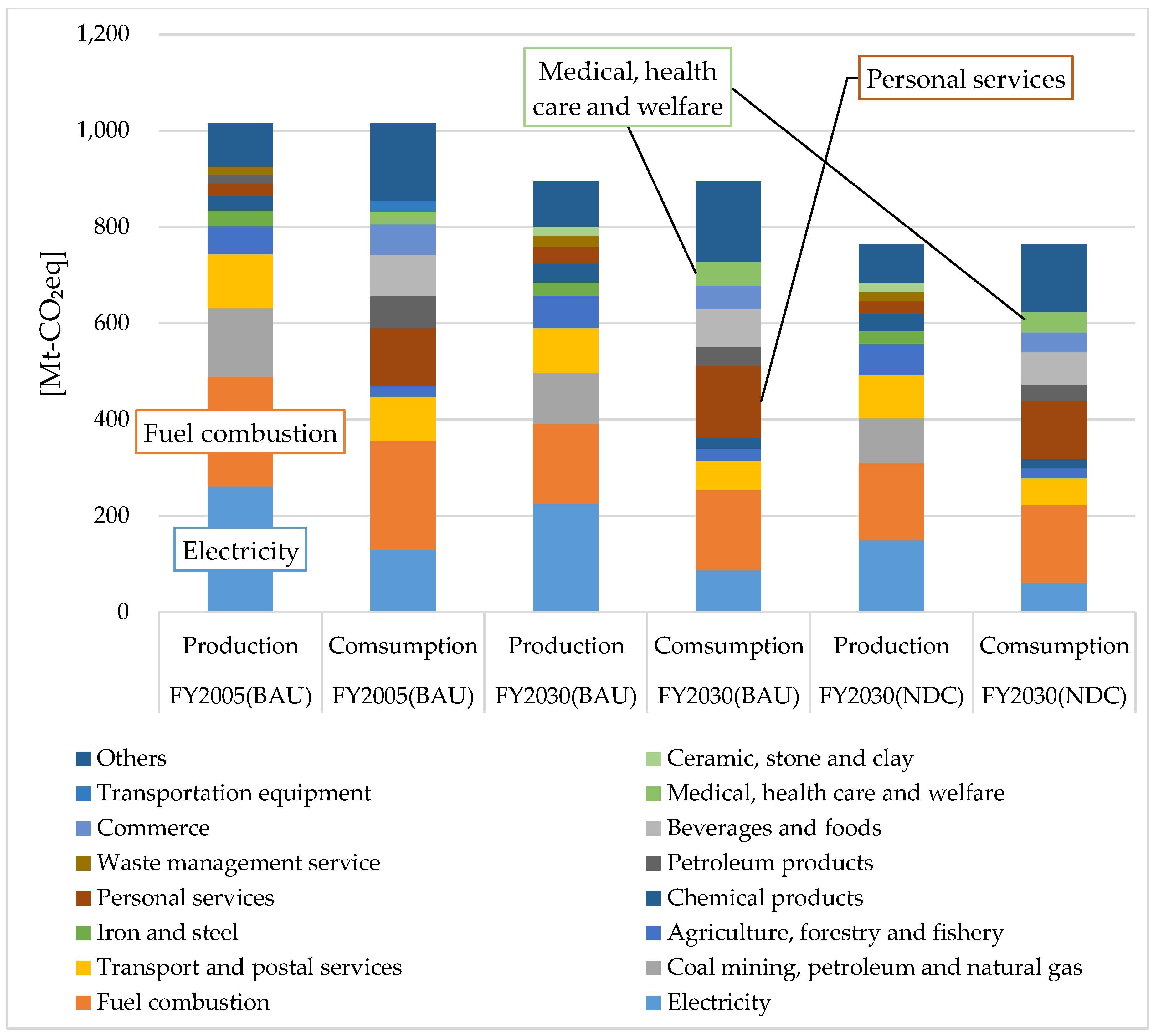

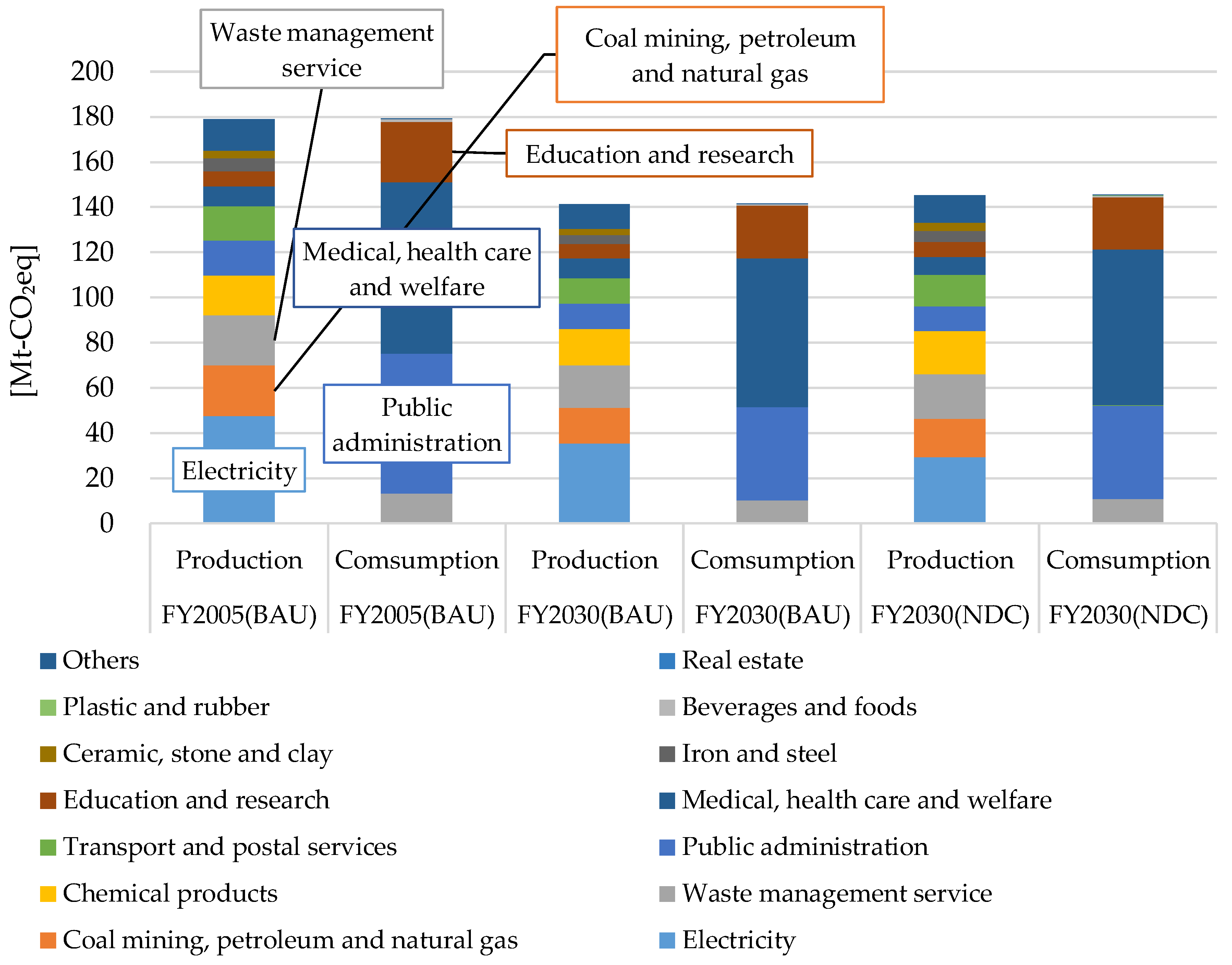
| Index | This Study | Oshiro et al. [13] | Oshiro et al. [27] |
|---|---|---|---|
| BAU (MtCO2eq) | 1251 | 1130 | 1160 |
| Mitigation (tCO2eq) | 1098 | 960 | 821 |
| GHG ratio (%) | −12 | −15 | −29 |
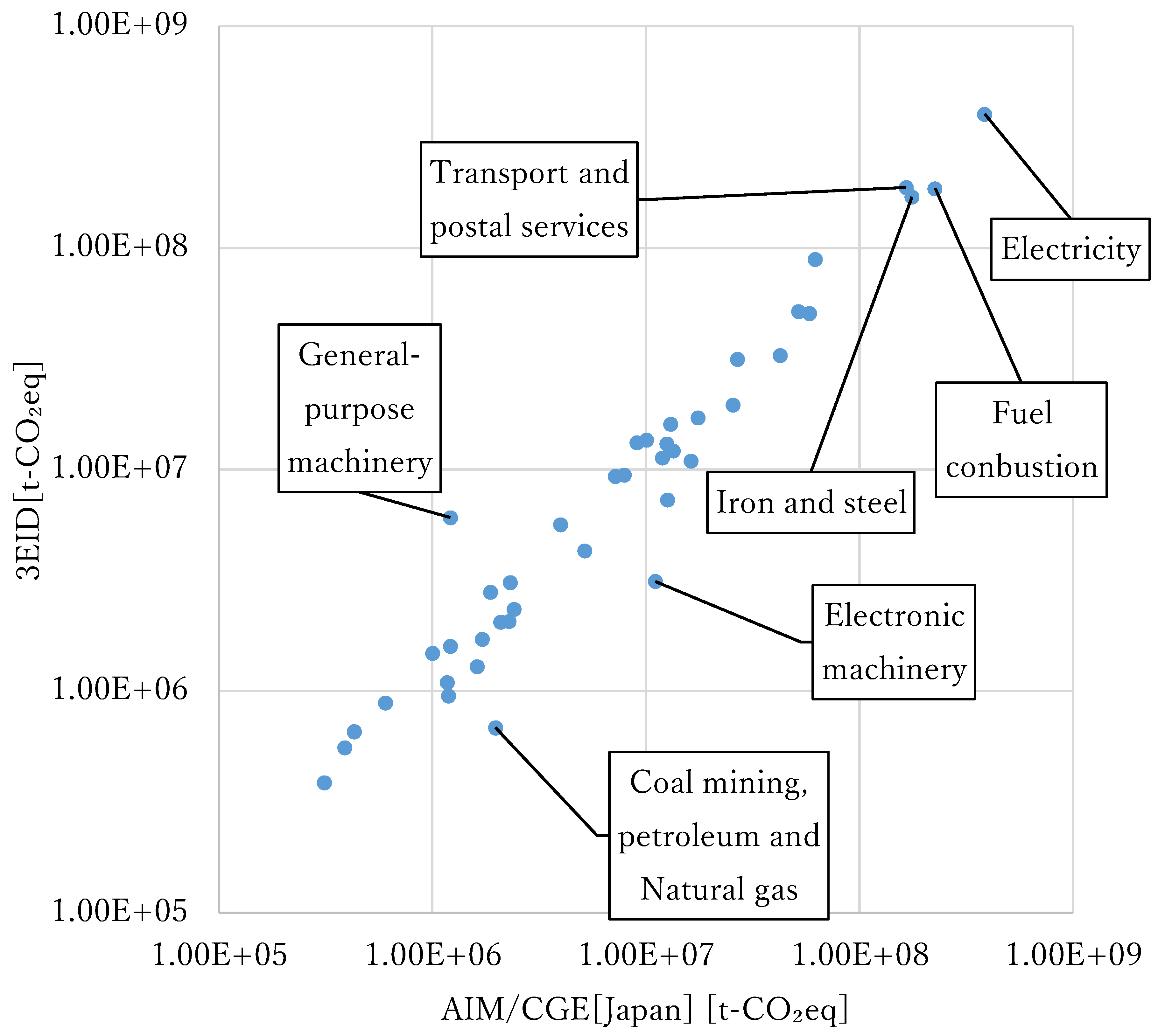
| Scenario | Sectors | Total | Household | Fixed Capital | Government |
|---|---|---|---|---|---|
| FY2005(BAU) | Agriculture, forestry and fishery | 23.8 | 22.6 | 1.3 | 0.0 |
| FY2005(BAU) | Mining | −0.1 | −0.1 | −0.0 | 0.0 |
| FY2005(BAU) | Coal mining, petroleum and natural gas | 0.0 | 0.0 | 0.0 | 0.0 |
| FY2005(BAU) | Beverages and foods | 86.9 | 85.9 | 0.0 | 1.0 |
| FY2005(BAU) | Textile products | 13.2 | 12.3 | 0.8 | 0.0 |
| FY2005(BAU) | Pulp and paper | 4.3 | 2.7 | 1.6 | 0.0 |
| FY2005(BAU) | Chemical products | 18.9 | 18.9 | 0.0 | 0.0 |
| FY2005(BAU) | Petroleum products | 66.8 | 66.8 | 0.0 | 0.0 |
| FY2005(BAU) | Coal products | 0.0 | 0.0 | 0.0 | 0.0 |
| FY2005(BAU) | Plastic and rubber | 6.3 | 6.3 | −0.0 | 0.0 |
| FY2005(BAU) | Ceramic, stone and clay | 3.2 | 3.2 | 0.0 | 0.0 |
| FY2005(BAU) | Iron and steel | −4.1 | −0.6 | −3.5 | 0.0 |
| FY2005(BAU) | Non-ferrous metals | 0.5 | 0.4 | 0.1 | 0.0 |
| FY2005(BAU) | Metal products | 3.7 | 2.1 | 1.6 | 0.0 |
| FY2005(BAU) | General-purpose machinery | 17.2 | 0.1 | 17.2 | 0.0 |
| FY2005(BAU) | Production machinery | 29.0 | 0.1 | 28.9 | 0.0 |
| FY2005(BAU) | Business oriented machinery | 14.9 | 1.7 | 13.2 | 0.0 |
| FY2005(BAU) | Electronic components | 0.9 | 0.9 | 0.0 | 0.0 |
| FY2005(BAU) | Electronic machinery | 27.3 | 10.9 | 16.4 | 0.0 |
| FY2005(BAU) | Information and communication electronics equipment | 27.2 | 13.3 | 13.9 | 0.0 |
| FY2005(BAU) | Transportation equipment | 50.4 | 23.0 | 27.4 | 0.0 |
| FY2005(BAU) | Miscellaneous manufacturing products | 7.4 | 4.8 | 2.6 | 0.0 |
| FY2005(BAU) | Construction | 173.1 | 0.0 | 173.1 | 0.0 |
| FY2005(BAU) | Electricity | 129.9 | 129.9 | 0.0 | 0.0 |
| FY2005(BAU) | Gas supply | 11.4 | 11.4 | 0.0 | 0.0 |
| FY2005(BAU) | Steam and hot water supply | 0.1 | 0.1 | 0.0 | 0.0 |
| FY2005(BAU) | Water supply | 6.7 | 6.7 | 0.0 | 0.0 |
| FY2005(BAU) | Waste management service | 16.4 | 3.2 | 0.0 | 13.2 |
| FY2005(BAU) | Commerce | 79.5 | 63.0 | 16.6 | 0.0 |
| FY2005(BAU) | Finance and insurance | 7.8 | 7.8 | 0.0 | 0.0 |
| FY2005(BAU) | Real estate | 20.6 | 20.6 | 0.0 | 0.0 |
| FY2005(BAU) | Transport and postal services | 95.8 | 91.0 | 4.7 | 0.0 |
| FY2005(BAU) | Information and communications | 19.5 | 11.0 | 8.4 | 0.0 |
| FY2005(BAU) | Public administration | 63.1 | 1.3 | 0.0 | 61.8 |
| FY2005(BAU) | Education and research | 38.8 | 12.1 | 0.0 | 26.7 |
| FY2005(BAU) | Medical, health care and welfare | 102.5 | 26.4 | 0.0 | 76.1 |
| FY2005(BAU) | Miscellaneous non-profit services | 4.8 | 4.8 | 0.0 | 0.0 |
| FY2005(BAU) | Business services | 7.7 | 4.8 | 2.9 | 0.0 |
| FY2005(BAU) | Personal services | 119.6 | 119.6 | 0.0 | 0.0 |
| FY2005(BAU) | Office supplies and activities not elsewhere classified | 0.1 | 0.1 | 0.0 | 0.0 |
| FY2005(BAU) | Fuel combustion | 226.5 | 226.5 | ||
| FY2030(BAU) | Agriculture, forestry and fishery | 25.7 | 24.6 | 1.1 | 0.0 |
| FY2030(BAU) | Mining | −0.1 | −0.1 | −0.0 | 0.0 |
| FY2030(BAU) | Coal mining, petroleum and natural gas | 0.0 | 0.0 | 0.0 | 0.0 |
| FY2030(BAU) | Beverages and foods | 78.8 | 78.1 | 0.0 | 0.6 |
| FY2030(BAU) | Textile products | 11.7 | 11.1 | 0.6 | 0.0 |
| FY2030(BAU) | Pulp and paper | 4.2 | 3.0 | 1.2 | 0.0 |
| FY2030(BAU) | Chemical products | 22.8 | 22.8 | 0.0 | 0.0 |
| FY2030(BAU) | Petroleum products | 38.9 | 38.9 | 0.0 | 0.0 |
| FY2030(BAU) | Coal products | 0.0 | 0.0 | 0.0 | 0.0 |
| FY2030(BAU) | Plastic and rubber | 6.1 | 6.1 | −0.0 | 0.0 |
| FY2030(BAU) | Ceramic, stone and clay | 3.8 | 3.8 | 0.0 | 0.0 |
| FY2030(BAU) | Iron and steel | −3.3 | −0.6 | −2.7 | 0.0 |
| FY2030(BAU) | Non-ferrous metals | 0.6 | 0.6 | 0.1 | 0.0 |
| FY2030(BAU) | Metal products | 2.6 | 1.5 | 1.1 | 0.0 |
| FY2030(BAU) | General-purpose machinery | 12.4 | 0.1 | 12.3 | 0.0 |
| FY2030(BAU) | Production machinery | 20.9 | 0.1 | 20.7 | 0.0 |
| FY2030(BAU) | Business oriented machinery | 11.6 | 2.0 | 9.6 | 0.0 |
| FY2030(BAU) | Electronic components | 1.0 | 1.0 | 0.0 | 0.0 |
| FY2030(BAU) | Electronic machinery | 20.7 | 8.3 | 12.4 | 0.0 |
| FY2030(BAU) | Information and communication electronics equipment | 25.3 | 15.2 | 10.1 | 0.0 |
| FY2030(BAU) | Transportation equipment | 35.0 | 15.3 | 19.6 | 0.0 |
| FY2030(BAU) | Miscellaneous manufacturing products | 6.8 | 5.0 | 1.8 | 0.0 |
| FY2030(BAU) | Construction | 104.0 | 0.0 | 104.0 | 0.0 |
| FY2030(BAU) | Electricity | 87.2 | 87.2 | 0.0 | 0.0 |
| FY2030(BAU) | Gas supply | 6.9 | 6.9 | 0.0 | 0.0 |
| FY2030(BAU) | Steam and hot water supply | 0.0 | 0.0 | 0.0 | 0.0 |
| FY2030(BAU) | Water supply | 6.7 | 6.7 | 0.0 | 0.0 |
| FY2030(BAU) | Waste management service | 13.9 | 3.7 | 0.0 | 10.2 |
| FY2030(BAU) | Commerce | 59.4 | 49.9 | 9.5 | 0.0 |
| FY2030(BAU) | Finance and insurance | 11.0 | 11.0 | 0.0 | 0.0 |
| FY2030(BAU) | Real estate | 17.9 | 17.9 | 0.0 | 0.0 |
| FY2030(BAU) | Transport and postal services | 63.6 | 60.5 | 3.1 | 0.0 |
| FY2030(BAU) | Information and communications | 21.2 | 14.2 | 7.0 | 0.0 |
| FY2030(BAU) | Public administration | 43.1 | 2.0 | 0.0 | 41.1 |
| FY2030(BAU) | Education and research | 45.0 | 21.7 | 0.0 | 23.3 |
| FY2030(BAU) | Medical, health care and welfare | 115.5 | 49.5 | 0.0 | 66.0 |
| FY2030(BAU) | Miscellaneous non-profit services | 5.2 | 5.2 | 0.0 | 0.0 |
| FY2030(BAU) | Business services | 8.0 | 5.9 | 2.1 | 0.0 |
| FY2030(BAU) | Personal services | 149.7 | 149.7 | 0.0 | 0.0 |
| FY2030(BAU) | Office supplies and activities not elsewhere classified | 0.1 | 0.1 | 0.0 | 0.0 |
| FY2030(BAU) | Fuel combustion | 167.0 | 167.0 | - | - |
| FY2030(NDC) | Agriculture, forestry and fishery | 23.0 | 22.0 | 1.0 | 0.0 |
| FY2030(NDC) | Mining | −0.1 | −0.0 | −0.0 | 0.0 |
| FY2030(NDC) | Coal mining, petroleum and natural gas | 0.0 | 0.0 | 0.0 | 0.0 |
| FY2030(NDC) | Beverages and foods | 68.0 | 67.3 | 0.0 | 0.7 |
| FY2030(NDC) | Textile products | 9.7 | 9.2 | 0.5 | 0.0 |
| FY2030(NDC) | Pulp and paper | 3.4 | 2.4 | 1.0 | 0.0 |
| FY2030(NDC) | Chemical products | 19.5 | 19.5 | 0.0 | 0.0 |
| FY2030(NDC) | Petroleum products | 34.4 | 34.4 | 0.0 | 0.0 |
| FY2030(NDC) | Coal products | 0.0 | 0.0 | 0.0 | 0.0 |
| FY2030(NDC) | Plastic and rubber | 4.9 | 4.9 | −0.0 | 0.0 |
| FY2030(NDC) | Ceramic, stone and clay | 3.1 | 3.1 | 0.0 | 0.0 |
| FY2030(NDC) | Iron and steel | −3.1 | −0.6 | −2.6 | 0.0 |
| FY2030(NDC) | Non-ferrous metals | 0.5 | 0.5 | 0.1 | 0.0 |
| FY2030(NDC) | Metal products | 2.4 | 1.4 | 1.0 | 0.0 |
| FY2030(NDC) | General-purpose machinery | 11.3 | 0.1 | 11.2 | 0.0 |
| FY2030(NDC) | Production machinery | 18.9 | 0.1 | 18.8 | 0.0 |
| FY2030(NDC) | Business oriented machinery | 10.0 | 1.6 | 8.4 | 0.0 |
| FY2030(NDC) | Electronic components | 0.9 | 0.9 | 0.0 | 0.0 |
| FY2030(NDC) | Electronic machinery | 18.3 | 7.3 | 11.0 | 0.0 |
| FY2030(NDC) | Information and communication electronics equipment | 21.1 | 12.5 | 8.6 | 0.0 |
| FY2030(NDC) | Transportation equipment | 31.3 | 13.8 | 17.5 | 0.0 |
| FY2030(NDC) | Miscellaneous manufacturing products | 5.7 | 4.1 | 1.6 | 0.0 |
| FY2030(NDC) | Construction | 92.3 | 0.0 | 92.3 | 0.0 |
| FY2030(NDC) | Electricity | 60.8 | 60.8 | 0.0 | 0.0 |
| FY2030(NDC) | Gas supply | 6.4 | 6.4 | 0.0 | 0.0 |
| FY2030(NDC) | Steam and hot water supply | 0.0 | 0.0 | 0.0 | 0.0 |
| FY2030(NDC) | Water supply | 5.0 | 5.0 | 0.0 | 0.0 |
| FY2030(NDC) | Waste management service | 13.4 | 2.7 | 0.0 | 10.8 |
| FY2030(NDC) | Commerce | 47.5 | 39.6 | 7.9 | 0.0 |
| FY2030(NDC) | Finance and insurance | 9.2 | 9.2 | 0.0 | 0.0 |
| FY2030(NDC) | Real estate | 14.4 | 14.4 | 0.0 | 0.0 |
| FY2030(NDC) | Transport and postal services | 58.8 | 55.8 | 3.0 | 0.0 |
| FY2030(NDC) | Information and communications | 17.6 | 11.6 | 6.0 | 0.0 |
| FY2030(NDC) | Public administration | 43.0 | 1.6 | 0.0 | 41.4 |
| FY2030(NDC) | Education and research | 41.4 | 18.2 | 0.0 | 23.3 |
| FY2030(NDC) | Medical, health care and welfare | 112.5 | 43.5 | 0.0 | 68.9 |
| FY2030(NDC) | Miscellaneous non-profit services | 4.5 | 4.5 | 0.0 | 0.0 |
| FY2030(NDC) | Business services | 6.8 | 5.0 | 1.8 | 0.0 |
| FY2030(NDC) | Personal services | 120.2 | 120.2 | 0.0 | 0.0 |
| FY2030(NDC) | Office supplies and activities not elsewhere classified | 0.1 | 0.1 | 0.0 | 0.0 |
| FY2030(NDC) | Fuel combustion | 160.7 | 160.7 | - | - |
References
- Global Warming of 1.5 °C. IPCC. Available online: https://www.ipcc.ch/sr15/ (accessed on 31 August 2019).
- Hellweg, S.; Canals, L.M.I. Emerging approaches, challenges and opportunities in life cycle assessment. Science 2014, 344, 1109–1113. [Google Scholar] [CrossRef] [PubMed]
- Arnold, T.; Tatyana, B.; Stefan, G.; Arjan, D.K.; Stephan, L.; Moana, S.; Konstantin, S.; Richard, W. The Global Resource Footprint of Nations. Carbon, Woter, Land and Materials Embodied in Trade and Final Consumption Calculated with EXIOBASE 2.1, 1st ed.; The Netherlands Organization for Applied Scientific Research: Amsterdam, The Netherlands, 2014; pp. 7–9. [Google Scholar]
- Official Statistics UK’s Carbon Footprint. GOV.UK. 2019. Available online: https://www.gov.uk/government/statistics/uks-carbon-footprint (accessed on 24 August 2019).
- Minx, J.C.; Wiedmann, T.; Wood, R.; Peters, G.P.; Lenzen, M.; Owen, A.; Scott, K.; Barrett, J.; Hubacek, K.; Baiocchi, G.; et al. Input-output analysis and carbon footprinting: An overview of applications. Econ. Syst. Res. 2009, 21, 187–216. [Google Scholar] [CrossRef]
- Nansai, K. Environmental Input-Output Database Building in Japan, 1st ed.; Springer: Dordrecht, The Netherlands, 2009; pp. 653–688. [Google Scholar] [CrossRef]
- Leontief, W. Quantitative Input and Output Relations in the Economic Systems of the United States. Rev. Econ. Stat. 1936, 18, 105–125. [Google Scholar] [CrossRef] [Green Version]
- Long, Y.; Yoshida, Y.; Dong, L. Exploring the indirect household carbon emissions by source: Analysis on 49 Japanese cities. J. Clean. Prod. 2017, 167, 571–581. [Google Scholar] [CrossRef]
- Nansai, K.; Fry, J.; Malik, A.; Takayanagi, W.; Kondo, Y. Carbon footprint of Japanese health care services from 2011 to 2015. Resour. Conserv. Recycl. 2019, 152, 104525. [Google Scholar] [CrossRef]
- Glen, P.P. Carbon footprints and embodied carbon at multiple scales. Curr. Opin. Environ. Sustain. 2010, 2, 245–250. [Google Scholar] [CrossRef]
- Siagian, U.W.R.; Yuwono, B.B.; Fujimori, S.; Masui, T. Low-Carbon Energy Development in Indonesia in Alignment with Intended Nationally Determined Contribution (INDC) by 2030. Energies 2017, 10, 52. [Google Scholar] [CrossRef] [Green Version]
- Asia-Pacific Integrated Model, AIM Project Team All Rights Reserved. Available online: http://www-iam.nies.go.jp/aim/ (accessed on 26 August 2019).
- Fujimori, S.; Kainuma, M.; Masui, T. Post-2020 Climate Action Global and Asian Perspective; Springer: Singapore, 2017; pp. 1–10. [Google Scholar]
- Akimoto, K.; Bianka, S.; Sano, F.; Oda, J.; Kainuma, M.; Masui, T.; Oshiro, K. MILES(Modeling and Informing Low Emissions Strategies) Project—Japan Policy Paper: A joint Analysis of Japan’s INDC; Research Institute of Innovative Technology for the Earth: Tsukuba, Japan, 2015; pp. 6–11. [Google Scholar]
- Oshiro, K.; Masui, T.; Kainuma, M. Post-2020 Climate Action Global and Asian Perspective; Springer: Singapore, 2017; pp. 143–156. [Google Scholar]
- PBL Netherlands Environmental Assessment Agency. Integrated Assessment of Global Environmental Chage with IMAGE 3.0. Available online: https://www.pbl.nl/sites/default/files/downloads/pbl-2014-integrated_assessment_of_global_environmental_change_with_image30_735.pdf (accessed on 26 October 2019).
- Hanaoka, T.; Masui, T. Co-benefit Reductions of Short-Lived Climate Pollutants and Air Pollutants by 2050 while Achieving the 2 Degree Target in Asia. J. Sustain. Dev. Energy Water Environ. Syst. 2018, 6, 505–520. [Google Scholar] [CrossRef]
- Hanaoka, T.; Masui, T.; Matsuoka, Y.; Hibino, G.; Fujiwara, K.; Motoki, Y.; Oshiro, K. AIM Enduse Model Manual AIM Interim Report 2015; National Institute for Environmental Studies: Tsukuba, Japan, 2015; pp. 1–8. [Google Scholar]
- Submission of Japan’s Intended Nationally Determined Contribution (INDC). Available online: https://www.env.go.jp/en/earth/cc/2030indc_mat01.pdf (accessed on 27 August 2019).
- Portal Site of Official Statistics of Japan. Available online: https://www.e-stat.go.jp/en/stat-search/files?page=1&layout=datalist&toukei=00200603&tstat=000001026283&cycle=0 (accessed on 27 August 2019).
- Greenhouse Gas Inventory Office of Japan. Available online: http://www-gio.nies.go.jp/aboutghg/nir/2016/NIR-JPN-2016-v3.0_rev_web.pdf (accessed on 27 August 2019).
- Ministry of Economy, Trade and Industry (METI). Long-Term Energy Supply and Demand Outlook. 2015. Available online: https://www.meti.go.jp/english/press/2015/pdf/0716_01a.pdf (accessed on 27 August 2019).
- National Institute of Population and Social Security Research. Population Projections for Japan (2016–2065). Available online: http://www.ipss.go.jp/pp-zenkoku/e/zenkoku_e2017/pp29_summary.pdf (accessed on 27 August 2019).
- The Federation of Electric Power Companies of Japan. Addressing to Climate Change Issue Brief. November 2015. Available online: https://www.fepc.or.jp/english/environment/annual_review/__icsFiles/afieldfile/2016/03/01/actionplan_e_2015_1.pdf (accessed on 27 August 2019).
- Embodied Energy and Emission Intensity Data for Japan Using Input-Output Tables. Available online: http://www.cger.nies.go.jp/publications/report/d031/eng/datafile/embodied/2005/403.htm (accessed on 27 August 2019).
- Leontief, W. Input-Output Economics, 2nd ed.; Oxford University: New York, NY, USA, 1986; pp. 10–30. [Google Scholar]
- Oshiro, K.; Masui, T. Diffusion of low emission vehicle and their impact on CO2 emission reduction in Japan. Energy Policy 2015, 81, 215–225. [Google Scholar] [CrossRef]
- Su, X.; Takahashi, K.; Fujimori, S.; Hasegawa, T.; Tanaka, K.; Kato, E.; Shiogama, H.; Masui, T.; Emori, S. Emission pathways to achieve 2.0 °C and 1.5 °C climate targets. Earth’s Future 2017, 5, 592–604. [Google Scholar] [CrossRef] [Green Version]
- Thomson, A.M.; Calvin, K.V.; Smith, S.J.; Kyle, G.P.; Volke, A.; Patel, P.; Delgado-Arias, S.; Bond-Lamberty, B.; Wise, M.A.; Clarke, L.E.; et al. RCP4.5: A pathway for stabilization of radiative forcing by 2100. Clim. Chang. 2011, 109, 77–94. [Google Scholar] [CrossRef] [Green Version]
- Strengers, B.J.; Van Minnen, J.G.; Eickhout, B. The role of carbon plantations in mitigating climate change: Potentials and costs. Clim. Chang. 2011, 88, 343–366. [Google Scholar] [CrossRef]
- Riahi, K.; Rao, S.; Krey, V.; Cho, C.; Chirkov, V.; Fischer, G.; Kindermann, G.; Nakicenovic, N.; Rafaj, P. RCP 8.5-A scenario of comparatively high greenhouse gas emissions. Clim. Chang. 2011, 109, 33–57. [Google Scholar] [CrossRef] [Green Version]
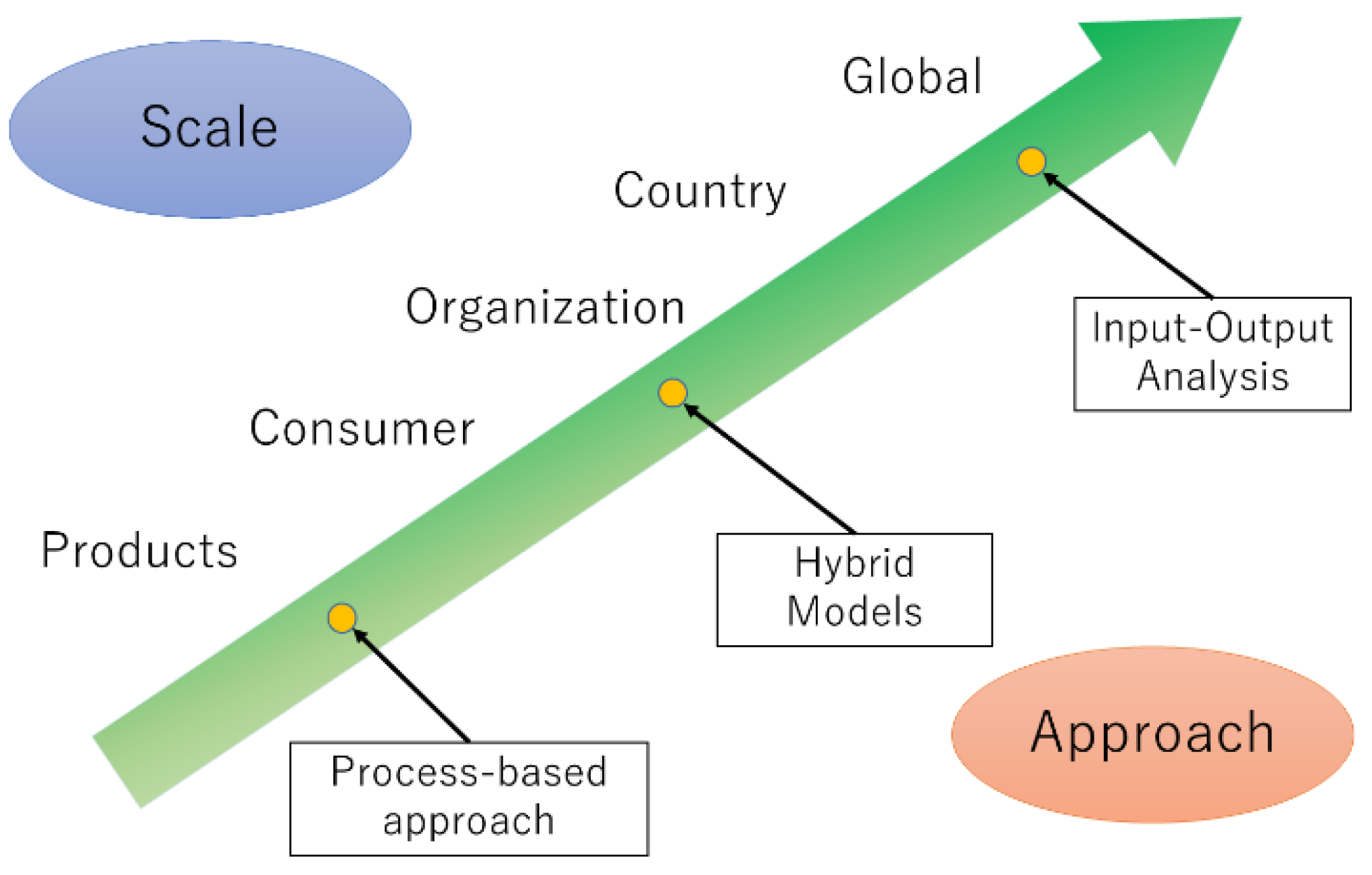



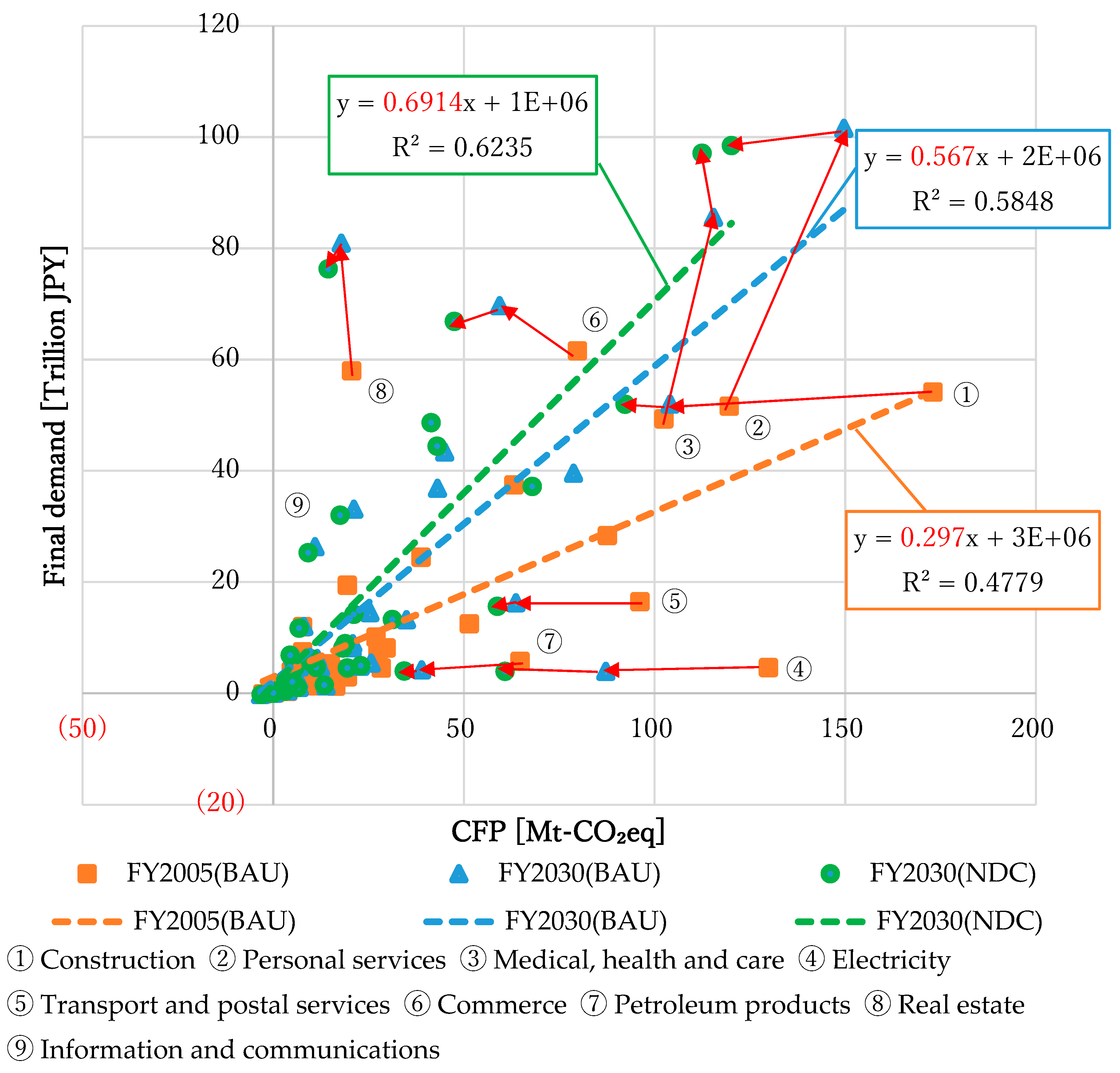
| Goods/Services (Row) | Goods/Services (Column) | Goods/Services (Row) | Goods/Services (Column) | ||||
|---|---|---|---|---|---|---|---|
| 1 | Agriculture, forestry, and fishery | 1 | Agriculture, forestry, and fishery | 24 | Electricity | 24p | Private power generation |
| 2 | Mining | 2 | Mining | 24n | Nuclear power generation | ||
| 3c | Coal mining | 3 | Coal mining, petroleum, and natural gas | 24tc | Coal thermal power generation | ||
| 3o | Petroleum | 24to | Petroleum thermal power generation | ||||
| 3g | Natural gas | 24tg | Gas thermal power generation | ||||
| 4 | Beverages and foods | 4 | Beverages and foods | 24h | Hydraulic power generation | ||
| 5 | Textile products | 5 | Textile products | 24s | Solar power generation | ||
| 6 | Pulp and paper | 6 | Pulp and paper | 24w | Wind power generation | ||
| 7 | Chemical products | 7 | Chemical products | 24g | Geothermal power generation | ||
| 8m | Petroleum products (motor vehicle) | 8 | Petroleum products | 24b | Biomass power generation | ||
| 8o | Petroleum products (other) | 25 | Gas supply | 25 | Gas supply | ||
| 9 | Coal products | 9 | Coal products | 26 | Steam and hot water supply | 26 | Steam and hot water supply |
| 10 | Plastic and rubber | 10 | Plastic and rubber | 27 | Water supply | 27 | Water supply |
| 11 | Ceramic, stone, and clay | 11 | Ceramic, stone, and clay | 28 | Waste management service | 28 | Waste management service |
| 12 | Iron and steel | 12 | Iron and steel | 29 | Commerce | 29 | Commerce |
| 13 | Nonferrous | 13 | Nonferrous | 30 | Finance and insurance | 30 | Finance and insurance |
| 14 | Metal products | 14 | Metal products | 31 | Real estate | 31 | Real estate |
| 15 | General-purpose machinery | 15 | General-purpose machinery | 32 | Transport and postal services | 32 | Transport and postal services |
| 16 | Production machinery | 16 | Production machinery | 33 | Information and communications | 33 | Information and communications |
| 17 | Business-oriented machinery | 17 | Business-oriented machinery | 34 | Public administration | 34 | Public administration |
| 18 | Electronic components | 18 | Electronic components | 35 | Education and research | 35 | Education and research |
| 19 | Electronic machinery | 19 | Electronic machinery | 36 | Medical, health care, and welfare | 36 | Medical, health care, and welfare |
| 20 | Information and communication electronics products | 20 | Information and communication electronics products | 37 | Miscellaneous nonprofit service | 37 | Miscellaneous nonprofit service |
| 21 | Transportation equipment | 21 | Transportation equipment | 38 | Business services | 38 | Business services |
| 22 | Miscellaneous manufacturing products | 22 | Miscellaneous manufacturing products | 39 | Personal services | 39 | Personal services |
| 23 | Construction | 23 | Construction | 40 | Office supplies and activities not elsewhere | 40 | Office supplies and activities not elsewhere |
| Index | FY2005 | FY2030 | Ratio (%) |
|---|---|---|---|
| Real GDP (trillion JPY at 2005 price) | 507 | 711 | 40.2 |
| Population (million persons) | 128 | 117 | −8.6 |
| GHG emissions (million tons CO2eq) | 1397 | 1042 | −25.4 |
| Index | FY2005 (BAU) | FY2030 (BAU) | FY2030 (NDC) |
|---|---|---|---|
| Final energy consumption (M kl) | 410 | 326 | 326 |
| Total power generation (billion kWh) | 1149 | 1056 | 1056 |
| Coal (%) | 24.1 | 30.4 | 24.7 |
| LNG (%) | 22.0 | 15.5 | 18.9 |
| Oil (%) | 11.8 | 0.00 | 1.20 |
| Nuclear (%) | 27.2 | 18.4 | 18.7 |
| Renewable energy (%) | 8.4 | 30.1 | 30.6 |
| Hydro (%) | 6.5 | 8.7 | 8.9 |
| Solar (%) | 1.0 | 12.5 | 12.7 |
| Wind (%) | 2.2 | 2.3 | |
| Geothermal (%) | 1.0 | 1.0 | |
| Biomass (%) | 5.7 | 5.8 | |
| Private (%) | 6.6 | 5.7 | 5.8 |
| Index | FY2005 (BAU) | FY2030 (BAU) | FY2030 (NDC) |
|---|---|---|---|
| CFP (megatons of carbon dioxide equivalent (MtCO2eq)) | 1535 | 1251 | 1098 |
| Population (million persons) | 128 | 117 | 117 |
| CFP per capita (tCO2eq) | 12.0 | 10.6 | 9.34 |
© 2019 by the authors. Licensee MDPI, Basel, Switzerland. This article is an open access article distributed under the terms and conditions of the Creative Commons Attribution (CC BY) license (http://creativecommons.org/licenses/by/4.0/).
Share and Cite
Ichisugi, Y.; Masui, T.; Karkour, S.; Itsubo, N. Projection of National Carbon Footprint in Japan with Integration of LCA and IAMs. Sustainability 2019, 11, 6875. https://0-doi-org.brum.beds.ac.uk/10.3390/su11236875
Ichisugi Y, Masui T, Karkour S, Itsubo N. Projection of National Carbon Footprint in Japan with Integration of LCA and IAMs. Sustainability. 2019; 11(23):6875. https://0-doi-org.brum.beds.ac.uk/10.3390/su11236875
Chicago/Turabian StyleIchisugi, Yuki, Toshihiko Masui, Selim Karkour, and Norihiro Itsubo. 2019. "Projection of National Carbon Footprint in Japan with Integration of LCA and IAMs" Sustainability 11, no. 23: 6875. https://0-doi-org.brum.beds.ac.uk/10.3390/su11236875




